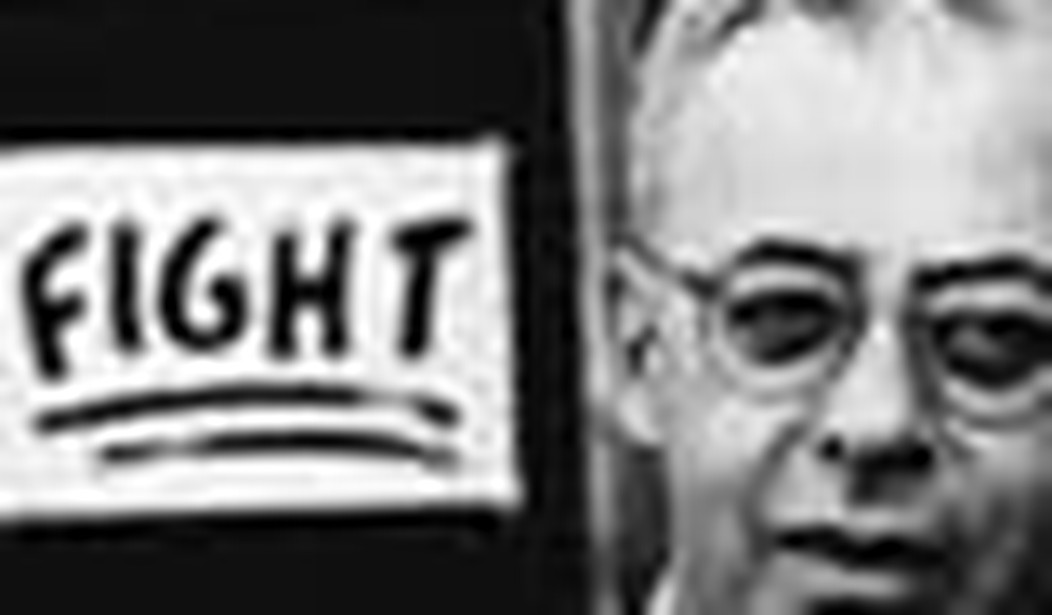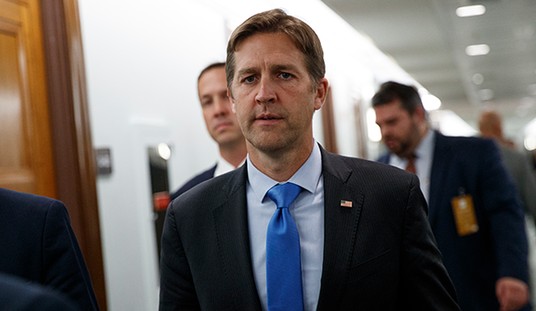As a member of the middle class Alinsky so despises for its “dreary, drab existence” (p. 121), I must apologize that the past month’s events involving my dismal life with my dull family and uninspired community crowded out the excitement of distilling Alinsky’s political genius for Pajamas Media readers. I’ll try not to let that happen again — after all, with the former counterrevolutionaries now in power going Animal Farm on us, we are set to be the next crop of political revolutionaries.
——————————–
As we wrap up Alinsky’s masterwork, let’s consider several layers:
1) The political situation prior to 1975;
2) The application of Alinsky’s philosophy by his disciples now relishing their status as Haves;
3) The potential for conservatives to co-opt Alinsky tactics to fight the new oppressors.
Chapter Six, “In the Beginning,” is key to understanding how the community organizer’s effectiveness is built on fomenting discontent:
If the organizer begins with an affirmation of his love for people, he promptly turns everyone off. If, on the other hand, he begins with a denunciation of exploiting employers, slum landlords, police shakedowns gouging merchants, he is inside their experience and they accept him. (p. 98)
The organizer’s job is to … agitate, introduce ideas, get people pregnant with hope and a desire for change. (p. 103)
Hope and change, anyone?
From the moment the organizer enters a community he lives, dreams, eats, breathes, sleeps only one thing and that is to build the mass power base of [what Alinsky calls] “the army.” (p. 113)
Here is the difference between past presidents and our first national community organizer-in-chief. Think ACORN. Think Organizing for America. A mobilization of masses of people religiously dedicated to doing the commander’s bidding.
The term “community organizer,” like so many leftist terms, is a typical bit of Orwellian doublespeak:
The first step in community organization is community disorganization. … The organizer dedicated to changing the life of a particular community must first rub raw the resentments of the people of the community. … He must search out the controversy and issues, rather than avoid them, for unless there is controversy people are not concerned enough to act. (pp. 116-117)
In the beginning, the organizer’s first job is to create the issues or problems:
People hunger for drama and adventure, for a breath of life in a dreary, drab existence. … It is a desperate search for personal identity — to let other people know that at least you are alive. … When the organizer approaches [someone living in a tenement] part of what begins to be communicated is that through the organization and its power he will get his birth certificate for life, that he will become known, that things will change … Television cameramen put their microphones in front of him and ask, “What is your name, sir?” … Nobody ever asked him his name before. (p. 121)
Moving from Alinsky theory (chapters two and three) into practical application (chapters four through seven) is a bit like sliding down a rabbit hole. There is that sense of a world disconnected from what has gone before. Yes, history repeats itself. Yes, there was FDR with his massive government programs and LBJ with his War on Poverty. But never have we had at the helm an organizer-in-chief who’s lived, breathed, and dreamed the Alinsky Way.
By now, it’s no secret that Obama’s path to power was paved with Alinsky tactics. Chapter Seven spells them out:
1) Power is not only what you think you have, but what the enemy thinks you have.
2) Never go outside the experience of your people.
3) Whenever possible, go outside the experience of your enemy.
4) Make the enemy live up to their own book of rules. Which explains why conservatives face greater consequences for moral failures than Democrats, who see nothing wrong with libertinism so have no shame when an old coot like Ted Kennedy is caught with his pants down. Time for conservatives to turn the tables and blame Obama for broken promises: Government transparency, troop escalation, etc.
5) Ridicule is man’s most potent weapon. Have you noticed that only the left is allowed to use ridicule? And how it can be directed even at a Republican candidate’s children, while Democrat kids are off limits? Maybe it’s time for conservatives to quit being so nice.
6) A good tactic is one your people enjoy. Black Panthers may enjoy intimidating white voters; ACORN thugs may like roughing people up at tea party protests.
7) A tactic that drags on too long becomes a drag.
8) Keep the pressure on, with different tactics and actions, and utilize all events of the period for your purpose.
9) The threat is usually more terrifying than the thing itself.
10) The major premise for tactics is the development of operations that will maintain a constant pressure on the opposition.
11) If you push a negative hard and deep enough it will break into its counterside.
12) The price of a successful attack is a constructive alternative.
13) Pick the target, freeze it, personalize it, and polarize it.
It is the last tactic that is best known because its implementation is so painfully obvious. O & Co. have done their best to make it a fine art form — targeting enemies from automakers and insurance companies to doctors and tea party activists. And let’s not forget Fox News. When Obama’s peevish callouts failed to silence them, his minions went to work on other news agencies to marginalize them. (To their credit, news organizations showed a rare moment of solidarity.) Again, unprecedented juvenile behavior came from the highest office in the land — and from Mr. Calm, Cool, and Collected.
Alinsky formulates a three-point strategy based on facial features:
First the eyes: If you have organized a vast, mass-based people’s organization, you can parade it visibly before the enemy and openly show your power.
But the Obama campaign seems so yesterday. Today we are seeing the radicalization of citizen patriots who — in true grassroots fashion — have organized tea parties, town hall gatherings, and Capitol steps protests (a la Michele Bachmann and Laura Ingraham).
Second the ears: If your organization is small in numbers, then do what Gideon did: Conceal the numbers in the dark but raise a din and clamor that will make the listener believe that your organization numbers many more than it does.
Reminding me so much of a teensy band of gay and atheist political activists who bombard our local newspapers with letters to the editor about any issue that comes up in our overwhelmingly conservative county on which they can take an anti-traditionalist stand. From the clamor they create, you’d think they represented thousands rather than a couple dozen.
Third, the nose; If your organization is too tiny even for noise, stink up the place. (p. 126)
While the reader may take that figuratively — I know I did — later in Chapter Seven, Alinsky gets literal when he suggests buying 100 symphony tickets, filling up 100 blacks with a free baked bean dinner and then sending them in to disrupt the concert by passing gas.
Page 139. I kid you not.
Alinsky says this illustrates tactics 2 and 3 — as it is not outside the experience of blacks and “connected with their hatred of Whitey,” while going outside the experience of the enemy — as presumably the Haves don’t eat beans en masse before attending the symphony.
Talk about dehumanizing and using people! I couldn’t help but think that had he raised money to buy 100 concert tickets for Have-Nots (whom he specifically identifies as blacks), some scattered children might have been dazzled into desiring to hear more or to learn how to play an instrument. One or two might have even pursued a musical career and risen from a state of being fed beans by a community organizer who considered them pawns in his own ugly performance art.
I guess this is the most telling part of Alinsky’s character: his lack of regard for his fellow man. And isn’t this the perpetual irony surrounding liberals, who claim to be all about defending the Have-Nots, when really they are just faces in crowds, bodies in buses, feathers in caps, rungs on ladders, bean-eating stooges to be organized by the brilliant disciples of Alinsky?
This also explains why a down-and-dirty community organizer behaves like a greedy conqueror upon achieving the White House — he feels absolutely entitled to live higher than the Haves, who he supposedly despised but secretly envied. Alinsky’s derision of love belies his attempts to draw biblical parallels with his ideas. Really, his brand of community organizing is the exact opposite of Christ’s, which was based on love and servant leadership.
Alinsky has only scorn for the middle class — particularly if they are content with their homes and their families. But he advises his “realistic radicals” to drop some of their rough and tumble ways (like calling policemen pigs) — the better to cozy up and convert the poor suckers incrementally to their more enlightened way of thinking. (p. 186)
Alinsky — circa 1971 — also called for an extreme makeover of American education, as it had a tendency to immunize the middle class masses against extreme emotion-driven political thought:
The products of [the American education] system have been trained to emphasize order, logic, rational thought, direction and purpose. (p. 166)
Well, we wouldn’t want that, would we? And nearly four decades later it would seem our education system has been successfully hijacked by Alinskyites — from kindergarten through postgraduate work, an American student can make the grade without order, logic, rational thought, direction, and purpose. Especially if his worldview and politics mesh with the teacher’s. Much of the National Education Association sees conservative parents as the enemy, so much so that the retiring general counsel felt free to pull a “pick the target, freeze it, personalize it, and polarize it” at their 2009 national convention.
Who knew that Alinsky was on the NEA’s suggested reading list? And in light of what we’ve learned from Rules for Radicals, should it be surprising that many teachers see themselves as mini-community organizers whose role would be to organize the underage troops to serve the organizer-in-chief? Mmmm, mmmm, mmmm … Barack Hussein Obama!
These are dangerous times we live in, with ruthless and amoral Alinskyites now in control of our institutions, and the Tired Old Media behaving more like giggling groupie girls than like — well, like reporters. But then there are those bugaboos they’re trying to avoid: Order, logic, rational thought, direction, and purpose.
Time for conservatives to take off the gloves. As the Who sang in “Won’t Get Fooled Again”: “Meet the new boss/Same as the old boss.” Time to use their own tactics to expose the hypocrisy of the Alinskyites who scrambled to the top only to become — like the pigs in Animal Farm — even worse oppressors than the ones they sought to overthrow. Time to set aside some of our own domestic contentment and make room for some of the drama and excitement Alinsky claimed his manipulation of the poor underclass would add to their “dreary, drab” lives.
Show up for tea parties, town halls, freedom marches and spontaneous Capitol steps meetings. Keep up the pressure. Forget civility. As you have been the target, turn this tactic back on them: pick it, freeze it, personalize it, and polarize it. And as this batch of Alinkyites did, never give up until the Haves (the new oppressor class) have been exposed for the hypocrites they are and sent to the dustbin of history.









Join the conversation as a VIP Member